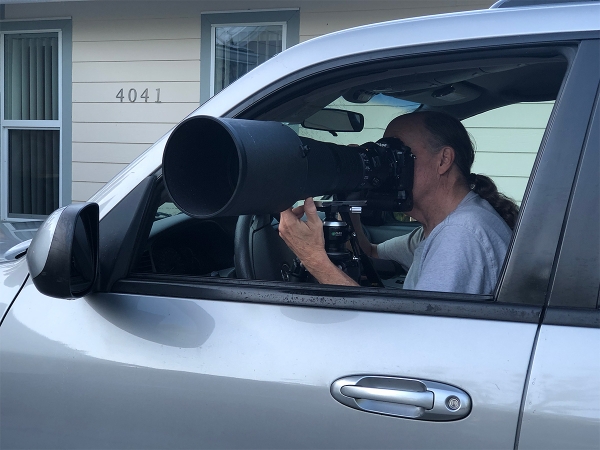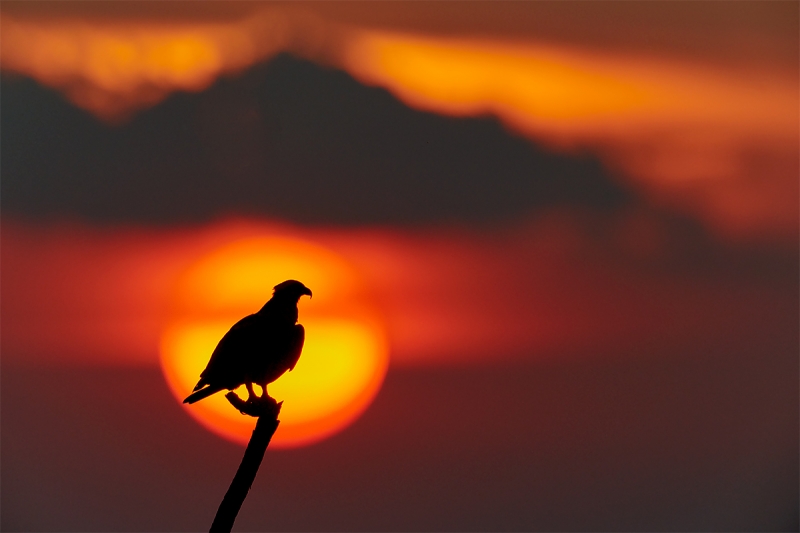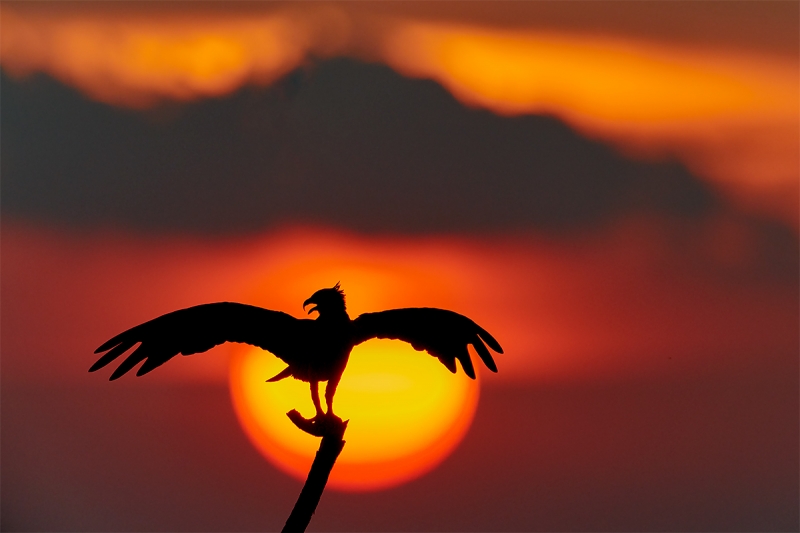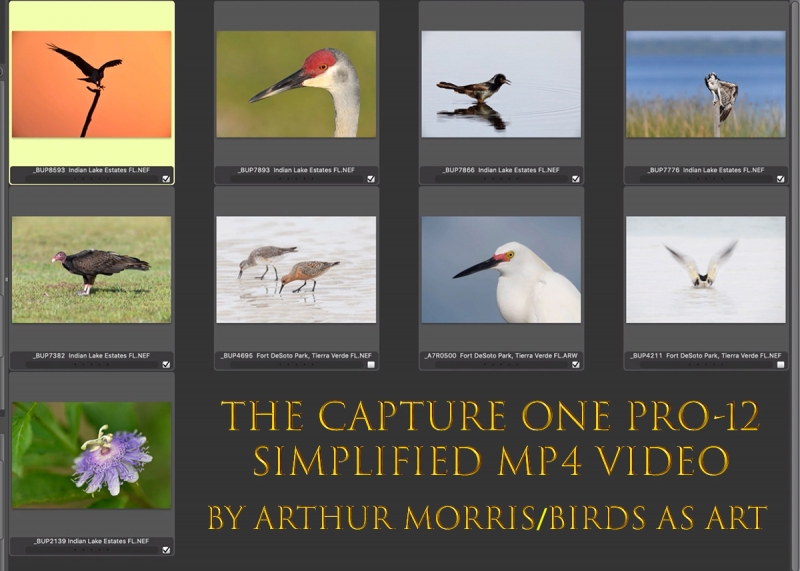What’s Up?
Lots.
Last night I went down to the lake as the wind was a gentle breeze from the northeast. There was an Osprey on the perch but the western sky was too, too clear. While I was tooling around, I found two medium-sized crane chicks that were surely hatched in May. Jim had told me about them. I saw them again this morning, Tuesday, June 4, 2019. Most of the crane nests here hatch in late February and March.
Several clutches of three Ospreys fledged about 10 days ago but the chicks had been hard to come by until this morning. I photographed one on the railing of the pier last week in a less than ideal situation. This morning I found two perched on 4X4 posts supporting a small dock. Not the greatest perches either but the birds and the light were gorgeous. Images and more soon.
I will start packing today for my trip to Northern Ontario on Thursday. I will have internet access the whole time. 🙂
My Final Offer: Huge Late-registration UK Puffins, Gannets, and Red Kites Instructional Photo-Tour Discount Increased Again!
The late-registration discount has been increased to $4,000.00.
The New, Expanded 2019 UK Puffins and Gannets IPT. Seahouses, Bempton Cliffs, and the Dunbar, Scotland Gannet boat to Bass Rock! Thursday, June 27 (from EDI) through Tuesday, July 9, 2019 (on the ground; fly home on Wednesday, July 10.): $9,999. Limit 5 photographers/Openings: 1
In an effort to fill a single remaining slot, I have increased the the late-registration discount for this great IPT from $3,000.00 to $4000.00. Click here and scroll down a bit for complete details. Please e-mail for additional information.
FlexShooter Pro Updates
A very few FlexShooter Pro heads are now in stock here in the BIRDS AS ART Online Store. We have sold 36 of the first forty that we received — all to positive reviews — and are expecting 20 more next week. We have the correct BigFoot plate available for all lenses but for the Nikon 600mm f/4 VR lens. Please place a phone order if you would like the plate to go with your new FlexShooter Pro head; they should be in the store by next week.
As most of you know, I am now using it for 100% of my tripod-mounted photogtraphy. See here and here to learn more. Or see the video here.
Last week I got my hands on the prototype for the new FLN-60 Bigfoot for the Nikon 600 VR. It is long enough to balance the 600 alone with any Nikon camera body and the best news is that the Wimberley F-1 Flash Bracket fits perfectly and mounts easily. I will post a photo here soon. We will have them in stock in about three weeks.
|
|
|
i-Phone 8+ image in Portrait Mode by Jim Litzenberg Setting the Tripod Up in the Vehicle/Best by far with the FlexShooter Pro |
The Setting up a Tripod in your Vehicle MP4 Video
$10 here in the BAA Online Store or free with your purchase of the life-changing FlexShooter Pro Head.
This seven-minute video will teach you exactly how to set up a tripod in most vehicles. You can do this with pretty much any tripod that does not have a center post. It is just one of the many reasons that I do not like or use a tripod with a center post. As I did for more than two decades, you can use this strategy with any ballhead or with a Wimberley V2 head or a Mongoose M3.6 action head, but the FlexShooter Pro has several huge advantages. First and foremost you are able to level the large silver ball. This enables you to pan with moving subjects and shoot action and even flight from the driver’s seat of your vehicle all while the camera remains 100% square to the world, aka “level.” The second big advantage is the FlexShooter Pro has a lower profile than either of the other two heads mentioned so that you can be low enough to work subjects on the ground that are relatively close to your car.
You can order your copy of this MP4 video here in BAA Online Store. It is free with the purchase of a FlexShooter Pro head. Those who have previously purchased the FlexShooter Pro from us can e-mail to request their free copy.
Selling Your Used Photo Gear Through BIRDS AS ART
Selling your used (or like-new) photo gear through the BAA Blog is a great idea. We charge only a 5% commission. One of the more popular used gear for sale sites charged a minimum of 20%. Plus assorted fees! Yikes. They went out of business. And e-Bay fees are now up to 13%. The minimum item price here is $500 (or less for a $25 fee). If you are interested please scroll down here or shoot us an e-mail with the words Items for Sale Info Request cut and pasted into the Subject line :). Stuff that is priced fairly — I offer pricing advice to those who agree to the terms — usually sells in no time flat. Over the past year, we have sold many dozens of items. Do know that prices on some items like the EOS-1D Mark IV, the old Canon 100-400, the old 500mm, the EOS-7D and 7D Mark II and the original 400mm DO lens have been dropping steadily. Most recently the price of used Canon 600mm f/L IS II lenses have been dropping like a rock with the introduction of the 600 III. You can always see the current listings by clicking here or on the Used Photo Gear tab on the orange-yellow menu bar near the top of each blog post page.
As used gear sales have slowed a bit in recent months — especially with dSLR bodies, there are lots of great buys right now both below and on the Used Gear Page.
New Listing
Canon EOS 7D Mark II Kit with the Canon EF-S 18-135mm f/3.5 – 5.6 IS STM Lens
IPT veteran Dane Johnson is offering a Canon EOS 7D Mark II in like-new condition (with a low shutter count of < 4700) with the Canon EF-S 18-135mm f/3.5 - 5.6 IS STM lens (in mint condition) for the crazy low price of only $999.00 (with extras!). The sale includes the front body cap, a BG-E16 battery grip (a $209.00 value), a RRS BGE16-L L-plate (a $125 value -- no longer available new from RRS), an extra LP-E6 battery, the charger, the strap, the original product box with user documents and all cables, the front and rear caps and the original box for the 135 along with the EW-73B lens hood, and insured ground shipping via major courier to US lower 48 addresses only. Your kit will not ship until your check clears unless other arrangements are made. Please contact Dane via e-mail or on his cell phone at 1-559-593-0989 (Pacifc time).
I loved my 7D II and to this day I am often amazed by many of the images that I created with it. It is the first choice camera body of highly skilled bird photographer BPN Avian Moderator Dan Cadieux (whose work has been featured here often — do a search in the little white box top right of each blog post for “Cadieux”), and more recently Ravi Harekatur (see the recent blog post here if you missed his great macro shots). The 18-135mm, made especially for Canon crop-factor bodies, is a great travel lens that with its 1.3 foot minimum focus distance offers macro capabilities. It alone sells new for $599.00. This is a truly great buy on an ideal starter kit for someone just getting into nature photography. Add the 100-400 II and you are good to go! artie
|
|
|
This image was created on the very late afternoon of May 27, 2019 down by the lake near my home. Working while seated in the front seat of my SUV, I used the Induro GIT 304L/FlexShooter Pro-mounted Nikon AF-S NIKKOR 600mm f/4E FL ED VR lens, the Nikon AF-S Teleconverter TC-14E III, and the mega mega-pixel Nikon D850 DSLR. ISO 800. Matrix metering at about zero: 1/2000 sec. at f/6.3 in Manual mode was perfect with the red channel clipped a bit. AUTO1 WB at 8:07:06pm with some thin clouds on the western horizon. Nikon Focus Peaking fine-tune value: a very significant +9. See the Nikon AF Fine-tune e-Guide here. Three down and four to the left Single Continuous (C in Nikon/AI Servo with Canon) AF was active at the moment of exposure. The single AF point was placed squarely on the bird’s neck. Image #1: Osprey centered in the ball of the muted sunClick on the image to enjoy a larger version. |
Photographing the Muted Ball of the Sun
I have enjoyed photographing the muted ball of the sun with long telephoto lenses and teleconverters for several decades. Unless you take extreme measures and use a complex technique to ensure eye safety, it is simply not a good plan to photograph the sun in a clear sky after it has been up for more than a very few minutes. I am pretty sure that I have covered that topic somewhere at some point … Or at least taught it on a Bosque IPT. (Note: my plan is to be leading two Bosque workshops this year, one just before and one just after Thanksgiving with an option for the whole nine yards. I will be announcing the dates and rates once I am able to secure my Special Use Permit.)
Whenever there are some light clouds or mist or fog near the horizon it is safe to photograph the sun without risking damage to your eyes (or as we will see in a blog post soon), to your camera. In years past I often worked at 1200mm when photographing muted suns in the early mornings or late afternoons, often with a crop factor camera body. It was easy to produce relatively huge in the frame suns. With Nikon, however, I pretty much max out at 840mm, the 600 VR plus the TCE-14.
While it is fun making images of muted suns, it is a lot more fun when you can include a bird in the frame and even more fun when you can silhouette the bird in the ball of the sun. The big challenge here is that the sun is effectively moving in the sky as the earth rotates; this makes positioning the bird exactly inside the sun very difficult — though the movement of the sun through the sky is very slow you do not have all day … Working from the car as I was with both of today’s images (photographed 19 seconds apart), means that you will be moving the vehicle every minute or so. In the late afternoons that means that I am moving the car backward as the sun moves to my right and in addition, maneuvering the car slightly higher on the slope that goes down to the lake so that I can keep the bird lined up with the sun …
Note that I increased the exposure 1/3 stop from Image #1 to Image #2 by decreasing the shutter speed from 1/2000 to 1/1600 second. As stressed here often on the blog it is imperative that you burn (over-expose) the RED channel (and actually the YELLOW channel as well when photographing vivid sunrise and sunsets. If you do not, the rest of the image will be rendered as underexposed mud. Proper technique also includes exposing so that you have significant blinkies on the brightest parts of the sun. That was the case with both of today’s featured images.
|
|
|
This image was also created on the very late afternoon of May 27, 2019 down by the lake near my home.19 second after the image above. Working while seated in the front seat of my SUV, I used the Induro GIT 304L/FlexShooter Pro-mounted Nikon AF-S NIKKOR 600mm f/4E FL ED VR lens, the Nikon AF-S Teleconverter TC-14E III, and the mega mega-pixel Nikon D850 DSLR. ISO 800. Matrix metering at about zero: 1/1600 sec. at f/6.3 in Manual mode was perfect with the red channel clipped a bit. AUTO1 WB at 8:07:25pm with some thin clouds on the western horizon. Nikon Focus Peaking fine-tune value: a very significant +9. See the Nikon AF Fine-tune e-Guide here. Three down and four to the left Single Continuous (C in Nikon/AI Servo with Canon) AF was active at the moment of exposure. The single AF point was placed on the base of the bird’s neck. Image #2: Osprey was wings raised in front of the ball of the muted sunClick on the image to enjoy a larger version. |
Understand …
That neither of today’s featured images would have been possible with the usual southwest winds in the afternoons. Wind against sun is what you need for silhouettes, in addition to a somewhat muted sun.
Which?
Which of the two images do you like best? Why? In what way or ways is Image #1 stronger than Image #2? In what way or ways is Image #2 stronger than Image #1?
A Great Capture One Pro 12 Tip
As mentioned above, the RED and YELLOW channels were toasted in the two RAW (NEF) files. Rather than decreasing the Exposure during the RAW conversion in Capture One, I tried moving the Highlight Slider to the right. (It is under the High Dynamic Range tab.) As I moved the slider farther and farther to the right, the RED (over-) Exposure Warnings diminished just as I got to 100. If you convert in ACR you might give this a try in similar situations. You will find Exposure Warning under View; the keyboard shortcut is Command E. It sometimes turns itself off without reason …
|
|
The Capture One Pro-12 Simplified Video
|
The Capture One Pro-12 Simplified Video
$15.00 via electronic download
As below, Capture One did a great job of converting the RAW (NEF) files for today’s featured images.
When I first heard about doing RAW conversions in Capture One Pro 12 I purchased the somewhat pricey program and tried to figure it out on my own. I was totally lost. So I did some reading online and was still very confused. Then I consulted Arash Hazeghi’s comprehensive The Nikon Photographers’ Guide to Phase One Capture One Pro e-Guide and while Arash does a great job of covering the fine points, I still had some difficulty getting started. I thought Who needs Sessions and who wants to have to Import images? So I consulted Patrick Sparkman, the BAA technical advisor. Patrick had been using C-1 Pro 12 for a while. We spent a good deal of time on FaceTime simplifying things. That video is a direct result of those conversations.
You can purchase your copy in the BAA Online Store here.
If you are new to Capture One Pro-12, please click here to order. Understand that C-1 Pro 12 is expensive for good reason … Are your photos worth it?
Here are some of the things you will learn in this 33+ minute video as we convert nine different RAW files (eight Nikon and one SONY) from soup to nuts, from Photo Mechanic through the RAW conversion in Capture One to Photoshop:
- 1-How to quickly and easily find your images while working in a simple file folder format.
- 2-How to customize your Exposure and Details tabs to streamline your workflow.
- 3-How to set the White and Black points using Levels.
- 4-How to adjust set the values for the relevant sliders including Exposure, White Balance, High Dynamic Range (the Highlight and Shadow sliders), and Clarity and Structure.
- 5-How to work at 100 or 200% and fine-tune your settings for Noise Reduction and Sharpness.
- 6-How to work with the Color Editor
If you are trying to get a handle on how to use this great RAW conversion engine for your Nikon and SONY images, this video is just what you have been looking for. It is meant to serve as an adjunct to Arash’s comprehensive The Nikon Photographers’ Guide to Phase One Capture One Pro e-Guide. For Canon shooters, Arash and I both recommend using DPP 4.
If In Doubt …
If in doubt about using the BAA B&H affiliate link correctly, you can always start your search by clicking here. Please note that the tracking is invisible. Web orders only. Please, however, remember to shoot me your receipt via e-mail.




Please Remember to use my Affiliate Links and to Visit the New BAA Online Store 🙂
To show your appreciation for my continuing efforts here, we ask, as always, that you get in the habit of using my B&H affiliate links on the right side of the blog for all of your photo and electronics purchases. Please check the availability of all photographic accessories in the New BIRDS AS ART Online Store, especially the Mongoose M3.6 tripod head, Wimberley lens plates, Delkin flash cards and accessories, and LensCoat stuff.
As always, we sell only what I have used, have tested, and can depend on. We will not sell you junk. We know what you need to make creating great images easy and fun. And please remember that I am always glad to answer your gear questions via e-mail.
I would, of course, appreciate your using our B&H affiliate links for all of your major gear, video, and electronic purchases. For the photographic stuff mentioned in the paragraph above, and for everything else in the new store, we, meaning BAA, would of course greatly appreciate your business. Here is a huge thank you to the many who have been using our links on a regular basis and those who will be visiting the New BIRDS AS ART Online Store as well.
Be sure to like and follow BAA on Facebook by clicking on the logo link upper right.
Typos
In all blog posts and Bulletins, feel free to e-mail or to leave a comment regarding any typos or errors. Just be right :).


















I really like the sun in 1st picture and really like the bird pose in the 2nd picture. They are both spectacular. I would love to hear more on doing this safely. I have enjoyed your Kingfisher picture of similar design for years. More on the safety and techniques involved would be much appreciated. Thanks.
Thanks. See David’s comment and my response to him below. THey about sum it up.
The Kingfisher image that graced the cover of Outdoor Photographer was created in a much more dangerous situation, dangerous to my right eye that is.
a
p.s. both photos state 1600 sec shutter speed.
I am seeing 1/1600 sec. here. Am I missing something?
a
Your notes just prior to the 2nd picture states you changed from 1/2000 to 1/1600 for the 2nd picture. So was 1st picture actually shot at 1/2000?
Thanks and fixed.
a
Absolutely fantastic images! I particularly like image #1 because of the position of the bird in the frame – any plans to enter it into the bbc or nature’s best 🙂
Is there a reason why you didn’t point the camera further to your left when framing the second image, to put the bird in the right hand side and give it space to look into?
Very much looking forward to more posts on this technique.
Best Wishes,
Jake
Thanks Jake. I too think that they are pretty special 🙂
To answer your question: “When unexpected action happens, push the shutter button.” In addition, note that I was using Single point AF … With the fairly strong backlight, there would have been a chance that I would have lost focus competely if I moved the AF point and had to re-acquire …
a
Superb stuff!
Good morning Guru. Both the Osprey-Sunset images are outstanding. Thank you for those.
Your advice for setting up tripod in the car is invaluable. However, I do it little differently. Position my tripod on the other front seat beside me and shoot both stills and videos with my prosumer Canon EOS 70D and EF 400mm f/5.6. This is especially helpful for the short video clips I started shooting these days particularly for preening birds that provide extra pleasure to my eyes. Furthermore, the touch focus option on the rear LCD provides accurate focusing for the moving subjects.
Best regards.
Quazi,
Shooting out the right side of the car is much more difficult as you need to twist your body awkwardly.
a
Guru, we have the British driving system in our country Bangladesh i.e., the car steering is on the right. This means I have to twist my body to the left.
All our vehicles cruise by the left lane of double lane roads.
Guru, would love to have u here in winter, our birding season. Numerous migratory birds from as far as Mongolia and Siberia arrive for wintering. They come in November and depart by end March. Our main protected wetland Tangua Haor hosted 140,000 (one hundred and forty thousand) water birds last season and I had the opportunity to watch and photograph them.
Thanks Quazi. I had not realized that you drive on the wrong side 🙂
I’d love to get there. Where exactly do you live?
a
Thank you Guru. If your disciple does everything wrong except, following you on bird photography; I hope u wouldn’t be that annoyed!
I live in Dhaka, Bangladesh. It’s a small country to the east of India. I’m a member of Bangladesh Bird Club that was established 23 years ago. We perform annual migratory bird census, ringing and satellite tagging of some of those birds every winter. If you really decide to visit us in winter; I can assure you the club will do its utmost to make your visit worthwhile.
The migratory birds incorporate Ducks, Two species of Shelducks, Geese, Gulls, Indian Skimmers, Raptors, Two species of Ibis and Shore Birds including Spoon-billed Sandpipers. However, it’s difficult to get close to them other than on a few occasions. Therefore, we capture whatever is possible. You can find a few of those on my NatGeo profile clicking on my name.
Looking forward to your response. You can also write to me in my email.
With thanks and best regards.
Interesting images. I love the second one more than first one. Thanks for sharing them.
Thanks Krishna. Why? Is #1 stronger than #2 in any way?
a
Open bil bill and wings makes image 2 stronger in my opinion.
Thanks David, I gotta say that I am a bit more liberal than you on this matter. As I have relayed here before my dear friend Alan Levine, a noted opthalmic surgeon, told me, “If you look away and the world looks purple you should not have been looking so quit it.” There was no purple world that evening 🙂
with love, a
Spectacular images, Artie! And you have discussed photographing the sun, here on this blog. Please allow me to add that the thin clouds in your photos are not protective of your eyes; only the sun’s being very close to the horizon is. My own rule, and it might not be conservative enough but I still can see, is never aim a telephoto lens or look at the sun directly if it’s more than one sun diameter above the horizon. Or unless it’s totally eclipsed by the moon. 🙂